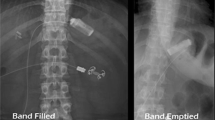Abstract
Background
Buried bumper syndrome is a rare complication of percutaneous endoscopic gastrostomy with an overgrowth of the inner flange of the tube. Various therapeutic approaches in case studies in the literature are described.
Methods
We present the prospective data collection and analysis of 18 cases of buried bumper syndrome treated in our institution between 1 January 1998 and 31 December 2005.
Results
The median length of time after the first percutaneous endoscopic gastrostomy (PEG) tube insertion was 35 months (range = 1–168 months). In 37 endoscopic interventions all ingrown PEG’s could be removed or replaced. Our experience resulted in a structured clinical treatment algorithm.
Conclusion
In all cases inadequate gastrostomy care must be assumed as the reason for bumper overgrowth. Following ESPEN guidelines for PEG care may prevent BBS. BBS can routinely be diagnosed and treated by upper gastrointestinal endoscopy in a minimally invasive manner.


Similar content being viewed by others
References
Braden B, Brandstaetter RN, Caspary WF, Seifert H (2003) Buried bumper syndrome: treatment guided by catheter probe US. Gastrointest Endosc 57: 747–751
Finocchiario C, Galletti R, Rovera G, Ferrari A, Todros L, Vuolo A, Balzola F (1997) Percutaneous endoscopic gastrostomy: a long-term follow-up. Nutrition 13: 520–523
Frascio F, Giacosa A, Piero P, Sukkar SG (1996) Another approach to the buried bumper syndrome. Gastrointest Endosc 43: 263
Gauderer MWL, Ponsky JL, Izant RJ (1980) Gastrostomy without laparotomy: a percutaneous endoscopic technique. J Paediatr Surg 15: 872–875
Gawenda M, Schmidt R, Schonau E (1996) The buried bumper syndrome – a rare complication of percutaneous endoscopic gastrostomy. Chirurg 67: 752–753
Gumaste VV, Krachman M, Pottipati A, Dave P (1993) Removal of an embedded PEG bumper. Gastrointest Endosc 93: 558–559
Klein S, Heare BR, Soloway RD (1990) “The buried bumper syndrome”: A complication of percutaneous endoscopic gastrostomy. Am J Gastroenterol 85: 448–451
Loser C, Aschl G, Hébuterne X, Methus-Vliegen EMH, Muscaritoli M, Niv Y, Rollins H, Singer P, Skelly RH (2005) ESPEN guidelines on artificial enteral nutrition – Percutaneous endsocopic gastrostomy (PEG). Clin Nutr 24: 848–861
Ma MM, Semlacher EA, Fedorak RN, Lalor AE, Duerksen DR, Sherbaniuk RW, Chapelsky CE, Sadowski DC (1995) The buried gastrostomy bumper syndrome: Prevention and endoscopic approaches to removal. Gastrointest Endosc 41(5): 505–508
Sauer B, Starlitz M (2004) Buried bumper – a new method of non-surgical removal. Z Gastroenterol 42: 227–232
Schwartz HI, Goldberg RI, Barkin JS, Phillips RS, Land A, Hecht M (1989) PEG feeding tube migration impaction in the abdominal wall. Gastrointest Endosc 35: 134
Seitz H, Telfeyan D, Vécsei V (1996) Nonendoscopic removal of percutaneous endoscopic gastrostomy catheter. Chirurg 67: 552–555
Sharma VK, Howden SW (2000) Meta-analysis of randomized, controlled trials of antibiotic prophylaxis for PEG. Am J Gastroenterol 95: 3133–3136
Sheers R, Chapman S (1998) The buried bumper syndrome: a complication of percutaneous endoscopic gastrostomy. Gut 43: 586
Author information
Authors and Affiliations
Corresponding author
Rights and permissions
About this article
Cite this article
Horbach, T., Teske, V., Hohenberger, W. et al. Endoscopic therapy of the buried bumper syndrome: a clinical algorithm. Surg Endosc 21, 1359–1362 (2007). https://doi.org/10.1007/s00464-006-9114-7
Received:
Accepted:
Published:
Issue Date:
DOI: https://doi.org/10.1007/s00464-006-9114-7




